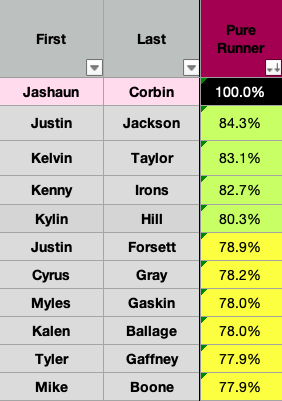This article is part of a series in which I evaluate 2022 rookie running backs solely on their ability to run the ball. The first installments of this series on PlayerProfiler, covering Jerrion Ealy and ZaQuandre White, can be found here. If you happened to already catch those and don’t need a refresher on my methodology, feel free to skip to the player-focused analysis below.
The Player
Florida State’s Jashaun Corbin is a theoretically enticing running back prospect given his sizable receiving role and sizable, well, size. He caught 60 passes in 35 college games, a 72nd-percentile rate among backs drafted since 2007. And he was listed at 6-0, 221-pounds on the Seminole roster in 2021. It’s probably true that he is a fine pass-catcher. But the rest of the profile for the former 4-star recruit is not what it seems.
Our guy actually began his career at Texas A&M. He backed up Trayveon Williams for a season before taking over the starting role as a true sophomore. In his first game as the lead back, Corbin went for 115 yards and 2 TDs. But he suffered a hamstring injury the following week. This setback opened the door for a freshman runner named Isaiah Spiller to assume the lead backfield role. Spiller smashed, and while Corbin eventually returned from his injury, there was no returning to RB1 duties in College Station. So he transferred to Florida State.
The Metrics
The teammates Jashaun Corbin played with over his entire career averaged a 3.45-star rating as high school recruits. This makes them a 59th-percentile group; on par with the caliber of runners that classmates like ZaQuandre White, Cam’Ron Harris, and Zonovan Knight played with. But while those guys proved more efficient on a per-carry basis than their backfield mates, Corbin substantially lagged behind his. His career YPC+ is -0.84, and his career Chunk Rate+ is -4.66-percent. These marks land in the 10th and 8th-percentiles, respectively. While he wasn’t making frequent trips to the secondary relative to his teammates, he wasn’t terrible once he got there. His 29.1-percent Breakaway Conversion Rate is a 43rd-percentile mark. It’s not good, but it’s at least in the realm of normal for an NFL prospect.
Corbin slogged along at nearly a yard per carry less than other Aggie and ‘Nole runners while seeing significantly fewer defenders in the box than they did. His average box count was 0.16 defenders lighter than his teammates’, an 11th-percentile discrepancy. Obviously, he failed to take advantage of those easier runways. His career Box-Adjusted Efficiency (or BAE) Rating shows us that the average Corbin rushing attempt was worth just 88.5-percent the output of the average rushing attempt of the other backs on his team. That’s a 5th-percentile showing and the 3rd-lowest mark in the class. Even if we give him the benefit of the doubt and only look at his single best box-count performance, the 107.9-percent Rating he produced on 147 carries against 6-man boxes would be a 27th-percentile mark. He failed to produce at more than 80-percent the rate of his teammates against every other box count.
Rushing Efficiency Score and Comps
Considering the low volume he was handling, and the advantageous situations in which he was carrying the ball, his team-relative efficiency numbers paint him as the stone-worst rusher of the football among 2022 backs. My running back model’s Rushing Efficiency Score (a composite that accounts for all the non-BAE metrics we’ve addressed here in addition to rushing volume, overall team strength, offensive line play, and strength of opponent) reflects that. The score he earns is a class-low 17.7 out of 100. According to a BAE-centric composite rating that I’m workshopping, he earns a lowly 15.6 out of 100. This is also the lowest in the class.
Back to the phrase “theoretically-enticing running back prospect.” As a capable pass-catcher with workhorse size, Corbin would check the bare-minimum boxes we want to see from NFL Draft hopefuls at the position. If you can handle volume or run inside (or whatever else it is that NFL coaches attribute to size) while also providing reliability in the passing game, you can play on all three downs. The rub with Corbin is that he’s not the 6-0, 221-pounds that Florida State listed him at on their gameday program; per his Senior Bowl weigh-in, he’s actually just 205-pounds at 5-11. That’s a massive difference. Not just in actual size, but in the roles that a player can reasonably fill at the next level given that size.
Combined with Corbin’s lack of skill as a ballcarrier, that difference means he looks less like a big satellite back than he does like a tall, skinny guy who sucks at running the football. Using the same metrics that contribute to the Rushing Efficiency composite in addition to height, weight, and athletic measurables, my running back model also generates comps for prospects in the “pure runner” category. Assuming he runs a 4.50 in the 40-yard dash at 5-11, 205-pounds, his most similar historical runners are the above.
Last Word
Put simply, Jashaun Corbin was bad in college and the players who were similar to him in college have either been bad in the NFL or fallen ass-backwards into volume for a year before then continuing to be bad. He also has the lowest Rushing Efficiency Score of any back on this list; the comps can’t even keep up with how terribly he ran the ball. My expectation for Corbin, therefore, is that he also is bad in the NFL. The takeaway here is that you absolutely should not waste a rookie pick on him.









